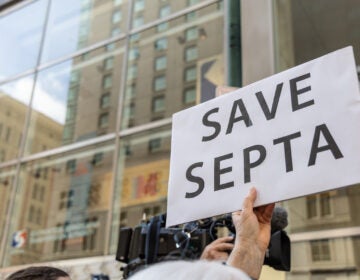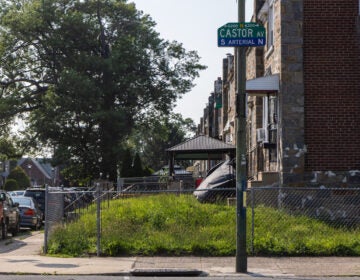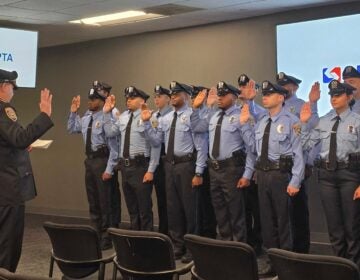SEPTA to install giant energy-saving battery
SEPTA has chosen the French company Saft to manufacture a giant battery it hopes will help lower energy costs on the Market-Frankford line in Philadelphia.
The battery, which will be housed in a custom-built shipping container in a substation near the Tioga stop in Kensington, will capture and store the energy released by trains when they decelerate.
“Currently, the majority of that energy is being wasted because there’s nothing to use that power,” said SEPTA’s Andrew Gillespie. “It becomes heat off the top of the car, so we want to capture that wasted energy.”
The battery will sit underground about a block away from the train tracks. Gillespie projects it will supply about 10 percent of the power needed out of that substation, and will save SEPTA around $100,000 a year in electricity costs.
Right now, a small percentage of energy released by decelerating trains is transferred through the third rail, to give nearby trains leaving the station a boost. The battery system however, would capture more energy and store it for a longer time.
The new battery will also bring in additional revenue by helping regulate the grid, making power available at times of peak electricity usage, said Audrey Zibelman, head of Conshohocken-based Viridity Energy, which is partnering with SEPTA on the effort.
Zibelman says batteries have been installed in New York train stations in a similar pilot project, but this is the first effort she knows about that will also be able to perform regulatory functions.
A SEPTA representative said the battery should be installed by January; if the project is successful, it may expand.
WHYY is your source for fact-based, in-depth journalism and information. As a nonprofit organization, we rely on financial support from readers like you. Please give today.
SEPTA details new bus routes, including Route 72
By Anthony Campisi
For PlanPhilly
Despite budget constraints, SEPTA’s staff is moving ahead with plans to introduce a new bus route that will serve Cheltenham and Olney. The new Route 72 line would operate between Rising Sun Avenue and Cedarbrook Plaza along Cheltenham Avenue and was suggested by Councilwoman Marian Tasco’s office, which originally called for the route to begin at Frankford Transportation Center.
Because of funding constraints, SEPTA wants to run the service every 30 minutes on weekdays from 10 a.m. to 3 p.m. and all day on weekends. It would serve Rising Sun Plaza and Cheltenham Square Mall. SEPTA announced the route schedule during a public hearing Monday on the fiscal year 2011 proposed service plan.
Steve D’Antonio, SEPTA’s manager of city service planning, said the authority wanted to provide all-day weekday service along Route 72 but opted to begin with midday service in order to gauge ridership levels. The route is projected to cost SEPTA about $408,000 annually. The authority would recover 24 percent of that cost through farebox revenue.
SEPTA is also proposing several other route changes that were detailed in previous public hearings. Among those changes, Route 43 and peak-hour Route 52 buses will now provide service to the West Parkside Industrial Park, which houses the Cintas Uniform Co.
The authority also wants to extend Route 97 to the Chestnut Hill Loop off Germantown Avenue. Route 97 serves Barren Hill, but many of the buses that travel that route also service Route 94, which runs through Chestnut Hill. SEPTA hopes the change will remove a transfer for some passengers.
SEPTA also wants to make changes to Routes 103, 105 and 106, which depart from 69th Street Terminal. The authority was asked to look at the routes as part of plans to revitalize the Ardmore Train Station.
The service planning division dropped a proposal to extend the Route 12, which serves West Philadelphia and Center City, down to the Columbus Commons Shopping Center in South Philadelphia. The Mayor’s Office of Transportation and Utilities requested the extension to provide direct service from Society Hill to South Philadelphia and a one-seat ride for Route 12 passengers to waterfront shopping destinations. SEPTA’s planners didn’t recommend the extension because an analysis found the new route would negatively impact Route 12’s operating ratio — the route would be making up a smaller percentage of its operating costs through farebox revenue than it does now.
The analysis also stated that the operating ratio of Route 25 would be negatively impacted because some riders might opt to take the new route instead. Route 25 is only 1 percent above SEPTA’s minimum acceptable operating ratio threshold of 22 percent.
The planning division also failed to recommend a proposal by the Montgomery County Planning Commission to extend the Route 95 from Plymouth Meeting Mall to Norristown via Plymouth Road. An analysis found that the proposal would negatively impact the route’s operating ratio.
The authority is delaying a decision on a bus link between Fairmount and University City employment centers that Fairmount residents have been asking for. SEPTA will examine whether altering Route 7 could accomplish that fix.
In a statement, the Delaware Valley Association of Rail Passengers expressed support for most of the changes. It also supports the city effort to extend the Route 12. The DVARP also lauded SEPTA staff for using the public hearing process to push through even minor route changes and expressed approval for the added information the authority is providing this year in its service plan proposal.
As part of the proposal, SEPTA also released information about route performance for the past year. Sixteen routes fell below SEPTA’s service standards in terms of farebox recovery ratios, including 11 city transit routes and five suburban transit routes. Ten regional rail stations also fell below minimum service standards, which call for at least 75 daily boardings or alightings. All but one of those stations, Eddington, has already received or is slated to receive renovations, and SEPTA hopes that the improvements will boost ridership. The authority is planning a marketing effort to boost ridership at Eddington.
Like SEPTA’s capital and operating budgets, the annual service plan proposal must be approved by a vote of the SEPTA Board, which is expected in July.
Patrick O’Malley, an independent hearing examiner, is taking public testimony before issuing a report to the board on the changes. Members of the public can present testimony at hearings through June 23. A full hearing schedule is here.
O’Malley is also taking written testimony through 4 p.m. June 28. Testimony can be either e-mailed to the SEPTA Board or mailed to:
SEPTA Board Secretary
1234 Market St.
Philadelphia, PA 19107
Contact the reporter at acampisi@planphilly.com
WHYY is your source for fact-based, in-depth journalism and information. As a nonprofit organization, we rely on financial support from readers like you. Please give today.







